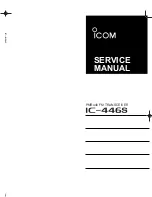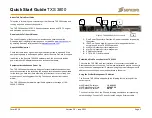
FCC ID: K66VX-5500L
Alignment
2/4
Vertex Standard Co., Ltd.
50-
Ω
RF Signal
Dummy load Generator
RF Sampling
Inline Wattmater Coupler
Transceiver
Deviation Meter CT-71
CT-29 Connection
Frequeuncy Cable Power Supply
Counter IBM PC 13.8V DC
COM port
Alignment Preparation & Precautions
A dummy load and inline wattmeter must be connected to the main antenna jack in all procedures that call
for transmission, except where specified otherwise. Correct alignment is not possible with an antenna.
After completing one step, read the following step to determine whether the same test equipment will be
required. If not, remove the test equipment (except dummy load and wattmeter, if connected) before
proceeding.
Correct alignment requires that the ambient temperature be the same as that of the transceiver and test
equipment, and that this temperature be held constant between 20 and 30 °C (68 and 86 °F). When the
transceiver is brought into the shop from hot or cold air it should be allowed some time for thermal
equalization with the environment before alignment. If possible, alignments should be made with oscillator
shields and circuit boards firmly affixed in place. Also, the test equipment must be thoroughly warmed up
before beginning.
Before beginning, connect the transceiver and PC using the CT-71 programming cable as described in
the EEPROM Programming chapter, and downloads the EEPROM data from the transceiver to the
computer.
Store this data in a disk file so that it can be saved and retrieved later. Using the table below, program the
channel, CTCSS, and DCS alignment settings for your transceiver version. Upload this file to the
transceiver.
Note: Signal levels in dB referred to in this procedure are based on 0 dBm = 0.5 µV (closed circuit).
Caution:
Do not connect this line to ground, and be certain that the speaker has adequate capability
to handle the audio output from the radio.
Because of the bridge audio amplifier circuit used in the radio, it is necessary to construct and use a
simple audio load test adapter as shown in the schematic diagram above, when conducting receiver
alignment steps.
3.5
φ
PLUG
Attenuated
Test Output (1/2)
2
Ω
10 W
Ground
+ 470 µF
2
Ω
10 W
AF Test Adapter Schematic






















